| 17 June |
• yesterday • tomorrow |
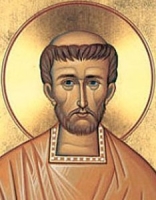
Botolph, Botulf, Botwulf
Born to a Christian Saxon noble family. Brother of Saint Adolph of Utrecht. Educated with his brother at the monastery of Cnobersburg (Burgh Castle), Suffolk under the direction of its founder, Saint Fursey. When Mercian forces under King Penda invaded the region, the boys were sent to study at the monastery at Bosanham, Sussex. He became a Benedictine monk at Farmoutiere-en-Brie, Gaul (modern northeastern France), and was sent back to the British Isles in 647 to establish the Benedictine Order there.
With the support of Saint Syre, Saint Aubierge, and their brother, King Anna of East Anglia, Botulph founded the monastery of Ikanhoe in East Anglia, declining the offer of a part of the royal estate, and settling for a wild, barren site that was removed from people, reported to be haunted by demons, and which would require endless work to sustain the monks. For many years it was believed that the area that grew up around it came to be called Botulph's Town, contracted to Botulphston, and later contracted to Boston in Lincolnshire, but recent reasearch has shown that the original site is another location. The Saxon Chronicle indicates that by 654 Botulph had attracted enough brother monks and hermits that work begain on the monastery. Through hard work and faith, the monastery grew in population; the monks built several structures, turned large areas of marsh and scrub into productive farming and grazing lands, and dispelled the people's fears of demons.
Botulph served as spiritual director for Saint Ceolfrith, and worked as a travelling missionary through rough, bandit-plagued areas of East Anglia, Kent and Sussex. His legacy continued for centuries in the strength of the Benedictine movement in the Isles, and in the dozens of churches named for him, many of them built at city gates to serve as safe-haven for travellers in times when robbers roamed the roads, and many in port or river towns.
c.610 in East Anglia (part of modern England)
• 17 June 680 of natural causes following a lengthy illness
• he died while being carried to chapel for compline services
• buried at Ikanhoe
• relics moved in 870 to keep them from being destroyed by invading Danes
• relics transferred to Grundisburgh in 983
• relics later distributed to monasteries at Thornery, Westminster, and Edmundsburg, Suffolk
• tradition says that for safety the cask of relics destined for Edmundsburg were taken there in the middle of the night, but the travellers were guided by a light that hovered above the relics' new shrine
• processions of the relics through Edmundsburgh has ended droughts there
• agricultural workers, farm workers, farmers
• sailors, mariners, watermen
• travellers
• 7 cities
• abbot holding a church in his hand
• abbot holding a monastery in his hand
• blue field with undulating silver lines superimposed with an inverted gold chevron with a gold cross at its point (his coat of arms)
The wearied man of God looked about him everywhere, till at last he found, by the mercy of God, such a desert spot which was just the God-forsaken, devil-possessed place he was in search of. - unknown ancient writer describing Botulph's selection of sites for his monastery
The evil spirits who people the place were disturbed at his coming. A noxious vapour was exhaled from the ground, and the daemons gave vent to terrifying groans. They had dwelt there, they said, for a long time, and had thought to do so for ever. They had no other place to go to. Why could not Saint Botolph seek some other spot, since the whole world was singing his praises? He was acting unkindly in disturbing them. - unknown ancient writer describing the problems Botulph caused evil spirits that inhabited the site of his Ikanhoe monastery
Saint Botulph sought a desert spot
And found a lonely mound,
He opened there a house of prayer
And made it holy ground.
He lived a humble, quiet life,
From crowded scenes apart;
Yet others often sought him out
To share his joy of heart.
- from a hymn by Jane Dansie, Castle Methodist Church, Colchester, England
https://catholicsaints.info/saint-botulph-of-ikanhoe/>
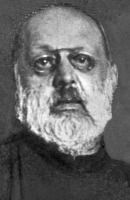
• Adam Chmielowski
• Adam Hilary Bernard Chmielowski
• Brat Albert
• Brother Albert
• Brother of Our Lord
• Brother of Our God
• Our God's Brother
Born to a wealthy aristocratic family, he initially studied agriculture in order to manage the family estate. Involved in politics from his youth, he lost a leg at age 17 when injured while fighting in an insurrection. In Krakow, he became a popular, well-known and well-liked artist. His interest in politics and art made him keenly aware of the human misery around him. A gentle and compassionate soul, he felt called to help those in need. After years of reflection, he understood that this desire was how God was calling him to service and Himself.
Franciscan tertiary, taking the name Albert. He abandoned painting, and began a life of working with and for the poorest of Krakow. In 1887 he founded the Brothers of the Third Order of Saint Francis, Servants of the Poor, known as the Albertines (named for him) or the Gray Brothers (after their rough gray habits). In 1891 he founded the women's congregation of the Order (Gray Sisters). The Albertines organized food and shelter for the poor and homeless.
Albert preached that the great calamity of our time was that so many refused to see and voluntarily relieve the suffering of their miserable brothers and sisters. The "haves" lived away from the "have-nots" in order to ignore them and leave their care to others.
In 1949, Pope John Paul II wrote a well-received play about Albert; the work was filmed in 1997, released as Brother of Our God. Albert was the spiritual teacher of Blessed Maria Bernardina Jablonska.
20 August 1845 at Igoalomia (Aigolonija), Poland as Adam Hilary Bernard Chmielowski
25 December 1916 at Krakow, Poland, of natural causes
12 November 1989 by Pope John Paul II at Saint Peter's Square, Rome
https://catholicsaints.info/saint-albert-chmielowski/
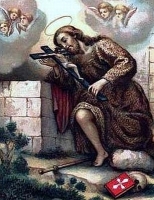
• Ranieri of Pisa
• Ranieri de Aqua
• Rainer, Rainerius, Rainier, Raniero, Raynerius, Regnier
Son of a wealthy merchant, he spent a wild and sinful youth as a wandering minstrel and musician, partying all night, sleeping by day if at all. One evening, while performing for a merry crowd in a castle, he met a holy man whose name has not come down to us. Ranieri felt drawn to the man, talked with him, and asked that the man pray for him. Whatever the man told him, Ranieri had a conversion experience, burned his fiddle, and gave up the life of a minstrel.
Falling back on what he learned from his father, Ranier became a merchant, trading with sailors and travelling from port to port. He was very successful, and while he lived a better life, it was still a worldly life. He built up quite a fortune, but one day found that his money gave off an evil stench. Ranieri took it as a sign, gave away his forture, and became a poor and penitential monk.
He made several penitential pilgrimages to Jerusalem and assorted holy shrines. Conventual oblate in the Benedictine abbey of Saint Andrew in Pisa, Italy in 1153. Oblate at the abbey of San Vito (Saint Guy) in Pisa. There he became known as a serious Bible student and sometime preacher, bringing to the pulpit his experience of working in front of an audience. An excellent speaker, he was a popular and romantic figure as the troubadour who traded his music for God, and was known for healing the sick with holy water.
1117 in Pisa, Italy
• 1161 at the abbey of Saint Vito, Pisa, Italy of natural causes
• buried in the Pisa Cathedral
by Pope Alexander III (cultus confirmation)
Pisa, Italy
• bearded hermit in a hairshirt holding a rosary
• dying man in a hairshirt
• minstrel burning his instrument while raising his arms to God
• monk being raised up by devils
• young pilgrim in a hairshirt carrying a banner with the Pisan cross
https://catholicsaints.info/blessed-ranieri-scacceri/
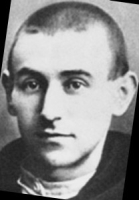
Marie-Joseph Cassant
A pious youth, Pierre-Joseph early felt a call to the priesthood, but after months of tutoring by his parish priest, it was obvious that Pierre-Joseph would not be able to master diocesan seminary studies. Instead, on 5 December 1894 he was sent to the Abbey of Sainte-Marie-du-Désert where the studies were simpler since there were no pastoral responsibilities, but where it was still an academic struggle. Benedictine Cisterian Trappist monk, taking the name Marie-Joseph. Member of the Association of Victim Souls. Ordained on 12 October 1902 after eight years of study; he lived nine months as a priest. Having developed tuberculosis, his health was already failing by the time of his ordination. He was sent home to his family for seven weeks to rest, but continued to decline and asked to return to the abbey where he spent his remaining time working in the infirmary.
6 March 1878 in Casseneuil, Lot-et-Garonne, France as Pierre-Joseph Cassant
17 June 1903 in Abbey of Sainte-Marie-du-Désert, Lévignac, Haute Garonne, France of tuberculosis
3 October 2004 by Pope John Paul II
over 2200 people from 30 countries claim to have received blessings thorugh Blessed Jean's intercession
For such a long time we hoped against hope to be able to have the whole family together after my ordination so as to share the joy of being present and receiving Communion together at my first Mass. The good Lord heard our deepest wishes. It now remains to us to thank Him and to enter more and more deeply into the greatness of the priesthood. Let us never dare to equate the Sacrifice of the Mass with earthly things. - Blessed Marie-Joseph in a letter to his family
https://catholicsaints.info/blessed-pierre-joseph-cassant/
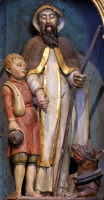
Erveo, Harvey, Herveus, Hervues, Hervé, Houarniaule, Huva
Son of the bard Hyvarnion, Herve was born blind. His father died when Herve was an infant, his mother, Rivanone, became an anchoress, and the boy was entrusted to the care of his uncles and a renowned holy man with whom he stayed until his teenage years. He lived for a while as a hermit and bard, then joined a monastic school at Plouvien, France which had been founded by his uncle. Abbot at Plouvien. He migrated with part of his community to found a new house in Lanhouarneau. Singer. Minstrel. Teacher. Miracle worker. One of the most popular saints in Brittany, he figures in the area's folklore. Reported to have a special ministry of healing animals, and to have a domesticated wolf as a companion. Legend says that the wolf killed and ate the ox that Herve used to plow his fields; Herve then preached such a moving sermon the wolf repented his ways, moved to Herve's hermitage, and ploughed Herve's fields in place of the ox.
Guimiliau, Brittany, France or unknown location in Wales (sources vary)
• c.556 to c.575 (sources vary) of natural causes
• interred at Lanhouarneau, Brittany, France
• against eye disease or eye problems
• blind people
blind man being led by a wolf
https://catholicsaints.info/saint-herve/
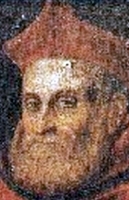
• Paolo Burali d'Arezzo
• Scipione
Graduated from the University of Salerno in 1525, and then from the University of Bologna in 1536; the future Pope Gregory XIII was one of his teachers. Layman civil and canon lawyer in Naples, Italy for twelve years. Royal counsellor to Emperor Charles V in 1549. Auditor general of the army under Ferdinand of Toledo. Joined the Theatines on 25 January 1557, taking the name Paolo. Spiritual student of Blessed Giovanni Marinoni. Ordained on 26 March 1558. Papal ambassador to the court of Spain for Pope Pius IV in 1564. Superior of the Theatine house of Naples. Superior of the Theatine house of Rome, Italy. Worked with Saint Andrew Avellino. Bishop of Piacenza, Italy on 23 July 1568. Created cardinal on 15 May 1570 by Pope Saint Pius V. Archbishop of Naples, Italy on 19 September 1576. Implemented the decrees of the Council of Trent. Published a catechism for priests in 1577.
1511 in Itri, diocese of Gaeta, Italy as Scipione
• 17 June 1578 at Torre del Greco, on the side of Mount Vesuvius, kingdom of Naples, Italy of natural causes
• interred in the crypt in the basilica of Saint Paul Maggiore, Naples
8 June 1772 by Pope Clement XIV
https://catholicsaints.info/blessed-paul-burali-darezzo/
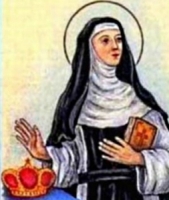
Tarasia, Teresa
Born a princess, the oldest daughter of King Sancho I. Married to King Alfonso IX of Leon, Spain; northern Portugal formed part of her dowry. Mother of three children. Several years into the marriage it was dissolved by the Vatican upon the revelation that Theresa and Alfonso were cousins. Single again, Theresa returned to Portugal where she converted the Benedictine monastery at Lorvão into a convent for 300 Cistercian nuns. Theresa then moved into the convent, though she did not take vows. In 1231 she left to settle a bitter succession dispute between her children over the throne of Leon. With peace between them, she returned to the convent, took vows, and remained there as a nun for the rest of her life.
4 October 1178 in Coimbra, Portugal
18 June 1250 at Lorvão Abbey, Portugal of natural causes
20 May 1705 by Pope Clement XI (cultus confirmed)
https://catholicsaints.info/saint-theresa-of-portugal/
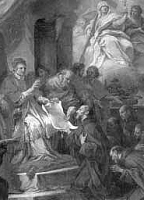
Peter of Pisa
Son of a government official and brother of Blessed Clara Gambacorta. At age 25, after a mis-spent youth and life at court, he left the world to become a beggar and hermit on Montebello in Umbria, Italy. Converted a band of thieves and bandits not just to Christianity but to religious life; he founded the Hermits of Saint Jerome with them. They were an ascetic group, observing fasts several days a week and a Lent each season of they year; the group soon built a church with hermit cells around it where they were all known for their piety and Peter as a miracle worker.
15 February 1355 in Pisa, Italy
17 June 1435 in Venice, Italy of natural causes
9 December 1693 by Pope Innocent XII
https://catholicsaints.info/blessed-peter-gambacorta/
• Hypatius of Bithynia
• Hypatius of The Oak
• the Scholar of Christ
Monk. Following a vision, he became a hermit at age 19 in Thrace, then Constantinople, and then Chalcedon, Bithynia with a friend and fellow hermit named Jason. Abbot at Chalcedon. Fierce opponent of Nestorianism. Sheltered Saint Alexander Akimetes and others at his hermitage near Chalcedon when their lives were threatened by Nestorian heretics. Hypatius is credited with halting a revival of the Olympic games because of their pagan origins. Prophet and miracle worker.
at Phrygia
c.450 of natural causes
https://catholicsaints.info/saint-hypatius-of-chalcedon/
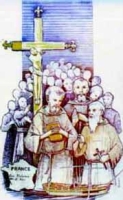
Priest of the diocese of Moulins, France. Imprisoned on a ship in the harbor of Rochefort, France and left to die during the anti-Catholic persecutions of the French Revolution. One of the Martyrs of the Hulks of Rochefort.
5 October 1744 in Saint-Pourçain, Allier, France
17 June 1794 aboard the prison ship Deux-Associés, in Rochefort, Charente-Maritime, France of general abuse a few moments after hearing the confession of another dying prisoner
1 October 1995 by Pope John Paul II
https://catholicsaints.info/blessed-philippe-papon/
Three well-educated Christian men who were sent as ambassadors from King Baltan of Persia to the court of emperor Julian the Apostate to negotiate peace between the two states, and an end of Julian’s persecutions of Christians. Instead of negotiating, Julian imprisoned them, ordered them to make a sacrifice to pagan idols, and when they refused, had them executed. Martyrs. Their names were Manuel, Sabel and Ismael.
Persian
• beheaded in 362 in Chalcedon (part of modern Istanbul, Turkey)
• bodies burned and no relics survive
https://catholicsaints.info/martyrs-of-chalcedon-17-june/
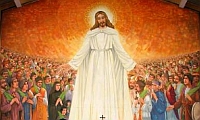
• Peter Da
• Peter Dja
Married layman in the apostolic vicariate of Central Tonkin (in modern Vietnam). Carpenter by trade, he served as sacristan at his parish. Imprisoned, tortured and executed in the persecutions of emperor Tu Duc. Martyr.
c.1802 in Ngoc Cuc, Nam Ðinh, Vietnam
burned at the stake on 17 June 1862 in Nam Ðinh, Vietnam
19 June 1988 by Pope John Paul II
https://catholicsaints.info/saint-phero-da/
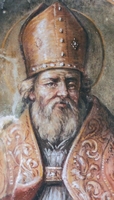
Monk at Amelia, Umbria, Italy. Bishop of Ameila.
at Calabria, southern Italy
• c.560 of natural causes
• relics translated to Cremona, Italy in 995
Cremona, Italy
https://catholicsaints.info/saint-himerius-of-amelia/
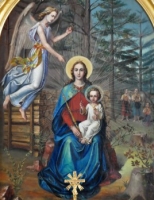
• Holy Mary in the Forest
• Maria im Walde
wooded area near Dolina, Grafenstein, Carinthia, Austria
17, 18 and 19 June 1849
An apparition of the Blessed Virgin Mary to three young shepherdesses in which Mary appeared as the Immaculate Conception.
https://catholicsaints.info/maria-in-the-forest/
Avit, Avy
Monk at the Menat monastery in Auvergne, France. Abbot of the Micy monastery near Orleans, France. Hermit in area of Perche, France. His reputation for holiness led to would-be spiritual students to gather around his shack. Eventually there were so many that they were led to build a new monastery where Avitus served as abbot.
c.530
https://catholicsaints.info/saint-avitus-of-perche/
Antel, Antible, Antidio, Tude
Spiritual student of Saint Froninus of Besançon. Bishop of Besançon, France. Martyred by Arian Vandals.
c.265 in Ruffey, France
https://catholicsaints.info/saint-antidius-of-besancon/
• Adolph of Maastricht
• Adulf, Adulphus
Brother of Saint Botulph of Ikanhoe. Seventh-century monk. Missionary bishop to Saxony. Miracle worker.
early 7th century England
https://catholicsaints.info/saint-adolph-of-utrecht/
Ramnold of Ratisbon
Monk at the Saint Maximinus monastery in Trier, Germany. Abbot of Saint Emmeram in Regensburg, Germany.
901
1001 of natural causes
https://catholicsaints.info/saint-rambold-of-ratisbon/
Dairchilla, Molignus, Moling, Mullins, Myllin
Monk at Glendalough. Abbot of Aghacainid. Bishop of Ferns, Ireland.
Wexford, Ireland
697 of natural causes
https://catholicsaints.info/saint-molling-of-wexford/
Archbishop of Bourges, France in 785 where he served the remaining 30 years of his life.
• 815 of natural causes
• interred in the church of the Saint-Laurent abbey in Bourges, France
https://catholicsaints.info/saint-david-of-bourges/
Martyr.
• on the Via Salaria Vecchia, Rome, Italy
• buried in the Saint John the Martyr, Via Salaria, Rome
• relics moved to the Basilica of Santa Praxedes by Pope Paschal I
https://catholicsaints.info/saint-diogenes-of-rome/
Martyr.
• on the Via Salaria Vecchia, Rome, Italy
• buried in the Saint John the Martyr, Via Salaria, Rome
• relics moved to the Basilica of Santa Praxedes by Pope Paschal I
https://catholicsaints.info/saint-blasto-of-rome/
Lay woman martyred with her two sons, whose names have not come down to us, in the persecutions of emperor Hadrian.
beheaded the early 1st century in Brescia, Italy
https://catholicsaints.info/saint-dignamerita-of-brescia/
Arnold
Franciscan friar. Confessor, spiritual director and biographer of Blessed Angela of Foligno.
1313
https://catholicsaints.info/blessed-arnaldo-of-foligno/
Soldier. Martyr.
• drowned in the sea with a stone tied around his neck c.300 on Ponza, Italy
• relics translated to Gaeta, Italy
https://catholicsaints.info/saint-montanus-of-gaeta/
Brevile
Sixth century hermit in Gloucestershire, England, and area now known as Saint Briavels.
https://catholicsaints.info/saint-briavel-of-gloucestershire/
Nighton
Sixth-century hermit in Hartland, Devon, England.
Wales
Hartland, England
https://catholicsaints.info/saint-nectan-of-hartland/
Early spiritual student of Saint Anthony the Abbot. Monk. Hermit. Lived to nearly 100 years of age.
late 3rd century Egypt
late 4th century of natural causes
https://catholicsaints.info/saint-prior/
Gundulfus, Gondulf, Gondon, Gondulphus
Sixth century bishop in Gaul.
at Bourges, France of natural causes
https://catholicsaints.info/saint-gundulphus/
Bishop of Como, Italy.
615 of natural causes
https://catholicsaints.info/saint-agrippinus-of-como/
A group of Christians who fled to a cave near Apollonia, Macedonia to escape persecution for his faith, but were caught and executed. Martyrs. The names we know are - Basil, Ermia, Felix, Innocent, Isaurus, Jeremias and Peregrinus.
beheaded at Apollonia, Macedonia
https://catholicsaints.info/martyrs-of-apollonia/
Four Christian martyrs memorialized together. No details about them have survived, not even if they died together - Ciria, Maria, Musca and Valerian.
c.100 in Aquileia, Italy
https://catholicsaints.info/martyrs-of-aquileia-17-june/
Three well-educated Christian men who were sent as ambassadors from King Baltan of Persia to the court of emperor Julian the Apostate to negotiate peace between the two states, and an end of Julian's persecutions of Christians. Instead of negotiating, Julian imprisoned them, ordered them to make a sacrifice to pagan idols, and when they refused, had them executed. Martyrs. Their names were Manuel, Sabel and Ismael.
Persian
• beheaded in 362 in Chalcedon (part of modern Istanbul, Turkey)
• bodies burned and no relics survive
https://catholicsaints.info/martyrs-of-chalcedon-17-june/
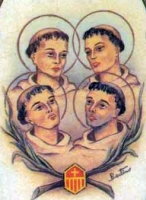
A group of Mercedarians sent to Fez, Morocco to ransom Christians imprisoned and enslaved by Muslims. For being openly Christian they were imprisoned, tortured, mutilated and executed. Martyrs - Egidio, John, Louis and Paul.
beheaded in Fez, Morocco
https://catholicsaints.info/martyrs-of-fez/
A group of 262 Christians martyred in the persecutions of Diocletian.
• c.303 in Rome, Italy
• buried on the old Via Salaria in Rome
https://catholicsaints.info/martyrs-of-rome/
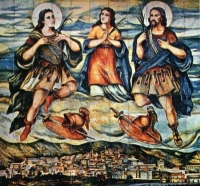
Three Christian lay people, two of them imperial Roman soldiers, who were converts to Christianity and were martyred together in the persecutions of Maximian and Diocletian - Daria, Marcian and Nicander.
• beheaded c.303 in Venafro, Italy
• by 313 a basilica had been built over their graves
• grave and relics re-discovered in 1930
Venafro, Italy
https://catholicsaints.info/martyrs-of-venafro/
• Colman of Lynn
• Herbot
• Joseph-Marie Cassant
CatholicSaints.Info Portable Edition